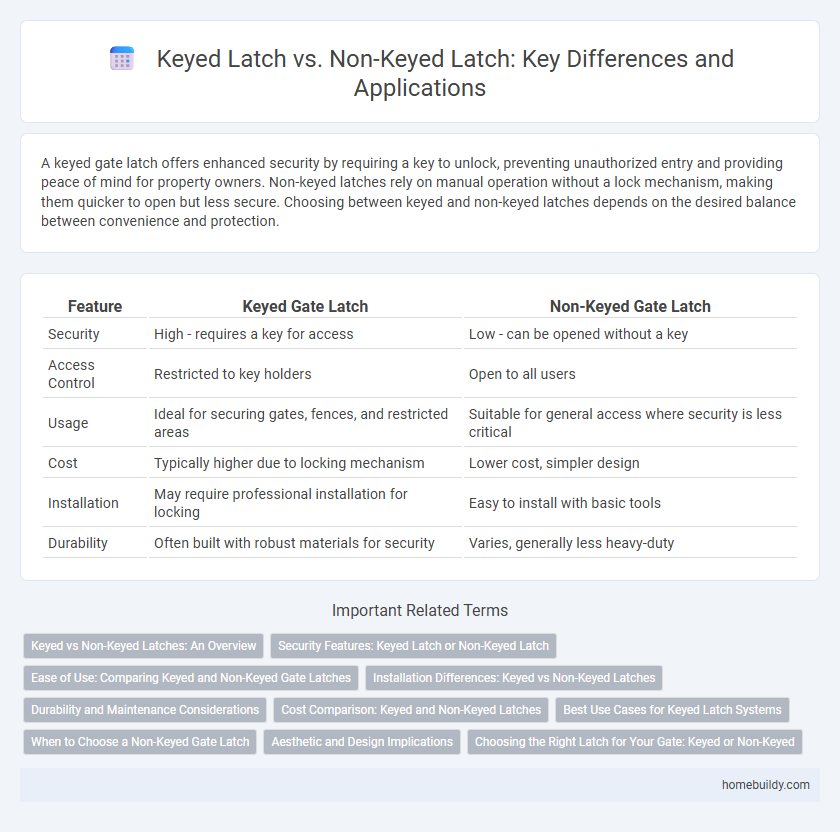A keyed gate latch offers enhanced security by requiring a key to unlock, preventing unauthorized entry and providing peace of mind for property owners. Non-keyed latches rely on manual operation without a lock mechanism, making them quicker to open but less secure. Choosing between keyed and non-keyed latches depends on the desired balance between convenience and protection.
Table of Comparison
| Feature | Keyed Gate Latch | Non-Keyed Gate Latch |
|---|---|---|
| Security | High - requires a key for access | Low - can be opened without a key |
| Access Control | Restricted to key holders | Open to all users |
| Usage | Ideal for securing gates, fences, and restricted areas | Suitable for general access where security is less critical |
| Cost | Typically higher due to locking mechanism | Lower cost, simpler design |
| Installation | May require professional installation for locking | Easy to install with basic tools |
| Durability | Often built with robust materials for security | Varies, generally less heavy-duty |
Keyed vs Non-Keyed Latches: An Overview
Keyed latches provide enhanced security by requiring a key to unlock, making them ideal for gates needing controlled access. Non-keyed latches offer convenience and quick operation without the need for a key, suitable for areas where security is less critical. Selecting between keyed and non-keyed latches depends on the balance between security requirements and ease of use.
Security Features: Keyed Latch or Non-Keyed Latch
Keyed latches provide enhanced security by requiring a specific key to unlock the gate, significantly reducing unauthorized access compared to non-keyed latches. Non-keyed latches offer easier and quicker access but lack the robust security features ideal for high-risk areas. Choosing between keyed and non-keyed latches depends on the security level needed for properties such as residential gates, commercial facilities, or restricted zones.
Ease of Use: Comparing Keyed and Non-Keyed Gate Latches
Keyed gate latches offer enhanced security by requiring a key to open, which can add a minor complexity to access but ensures controlled entry. Non-keyed gate latches provide quicker and more convenient operation with simple push or pull mechanisms, ideal for frequent use without security concerns. Selecting between keyed and non-keyed latch depends on balancing ease of use with security needs for your gate.
Installation Differences: Keyed vs Non-Keyed Latches
Keyed latches require precise alignment for installation, as the key cylinder must fit securely within the gate frame, often necessitating pre-drilled holes and reinforced mounting points to support the locking mechanism. Non-keyed latches offer simpler installation, typically involving standard screws or bolts without the need for additional modifications, making them ideal for quick setups or gates without security concerns. The complexity and time involved in installing keyed latches are higher due to the need for accurate positioning and sometimes additional hardware to accommodate the locking cylinder.
Durability and Maintenance Considerations
Keyed gate latches offer enhanced durability due to reinforced locking mechanisms designed to resist forced entry and weather-related wear, extending their lifespan compared to non-keyed latches. Maintenance for keyed latches often involves regular lubrication of the lock cylinder and checking for alignment issues to ensure smooth operation. Non-keyed latches typically require less maintenance but may suffer quicker wear under heavy use or exposure to harsh environmental conditions, impacting their long-term reliability.
Cost Comparison: Keyed and Non-Keyed Latches
Keyed latches typically cost more than non-keyed latches due to the added complexity of the locking mechanism and the need for keys, which increase manufacturing and material expenses. Non-keyed latches offer a more economical option, making them suitable for applications where security is less critical and budget constraints are a priority. The cost difference impacts installation choices in both residential and commercial gate security solutions, with keyed latches preferred for higher protection levels despite the higher price.
Best Use Cases for Keyed Latch Systems
Keyed latch systems provide enhanced security by requiring a key for gate access, making them ideal for residential properties, commercial facilities, and restricted areas where unauthorized entry must be prevented. These latches are best used in environments demanding controlled access, such as gated communities, storage yards, and industrial sites, ensuring only authorized personnel can open the gate. Non-keyed latches suit low-security needs or frequently accessed gates, but keyed latches offer superior protection against tampering and theft.
When to Choose a Non-Keyed Gate Latch
A non-keyed gate latch is ideal for interior gates or areas where quick and easy access is necessary without compromising basic security. Choose a non-keyed latch for privacy or convenience, such as garden gates, pool areas, or fencing around children's play zones, where immediate release from either side is preferred. Non-keyed latches reduce the risk of lockouts and provide efficient operation in low-risk environments.
Aesthetic and Design Implications
Keyed gate latches offer enhanced security with a more robust and often bulkier design that can affect the overall aesthetic of a gate by introducing visible lock mechanisms. Non-keyed latches provide a cleaner, minimalist look favored in modern or decorative gate designs, maintaining smooth lines without protruding lock components. Choosing between keyed and non-keyed latches impacts not only functionality but also the visual harmony and architectural style of the gate installation.
Choosing the Right Latch for Your Gate: Keyed or Non-Keyed
Choosing the right gate latch depends on security needs and convenience; keyed latches offer enhanced protection by requiring a key for access, making them ideal for high-security areas. Non-keyed latches provide quick and easy entry, suitable for low-security zones or frequently accessed gates. Assessing the balance between safety and accessibility ensures the optimal latch type for your gate.
keyed latch vs non-keyed latch Infographic

 homebuildy.com
homebuildy.com